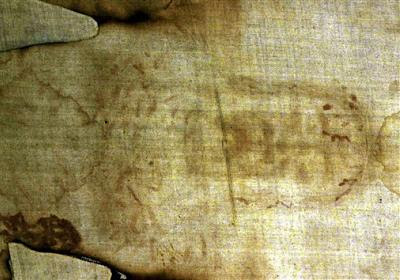 New research performed in Italy suggests that the discolorations on the Shroud of Turin could have been produced by ultraviolet light. By exposing pieces of linen to bursts of light in the ultraviolet spectrum, researchers have been able to replicate many of the same characteristics observed in the fibers of the mysterious Shroud.
New research performed in Italy suggests that the discolorations on the Shroud of Turin could have been produced by ultraviolet light. By exposing pieces of linen to bursts of light in the ultraviolet spectrum, researchers have been able to replicate many of the same characteristics observed in the fibers of the mysterious Shroud.Italian researchers at the National Agency for New Technologies, Energy and Sustainable Economic Development say they believe the image was created by an ultraviolet "flash of light." However, if that theory is true, it remains a mystery as to exactly how that technology could have been implemented at the time of the Shroud's creation. While the technology is readily available in present day, it was far beyond the means of anyone around pre-20th Century.
The Turin Shroud is said to be the burial cloth of Jesus, but has long been believed to be a fake, created during medieval times. It is currently kept in a climate-controlled case in Turin cathedral. Scientists at the Italian agency have reportedly spent years attempting to recreate the Shroud's imagery. 'The results show a short and intense burst of UV directional radiation can colour a linen cloth so as to reproduce many of the peculiar characteristics of the body image on the Shroud of Turin,' the scientists said.
One of the reasons I've always been skeptical of the idea that the Shroud of Turin was in fact the burial cloth of Jesus is a problem of geometry. Let's say that you take a mannekin and lay it down on a slab, then cover the face with some sort of paint. If you then lay a cloth over the body to take an impression the image you get looks nothing like what's found on the Shroud. Because the cloth falls around the head when it covers the mannekin's face the image made by the paint will come out much wider than the original. As you can see from the image above, however, the face on the Shroud shows no signs of this sort of distortion.
While the ultraviolet light idea is intriguing, this geometric problem would mean that not only would Jesus have to have emitted ultraviolet light, but prior to that happening the cloth would have to have been lifted some distance from the body so that the resulting image would turn out like that from a camera. I heard an interesting theory years ago that the Shroud may have been an early attempt to produce a photograph using medieval technology. If a cloth is treated with chemicals and exposed to sunlight passing through a lens or even a small aperture for a long enough period of time the ultraviolet rays will discolor portions of the cloth and create a photograph-like image. It seems to me that these new ultraviolet findings could provide evidence that some similar method was indeed involved.
UPDATE: Morgan has more, offering up his own hypothesis that the Shroud is in fact the burial shroud of Frater RC, whose alleged time of death lines up with the carbon dating performed in 1988. Maybe he's onto something there.


























No comments:
Post a Comment